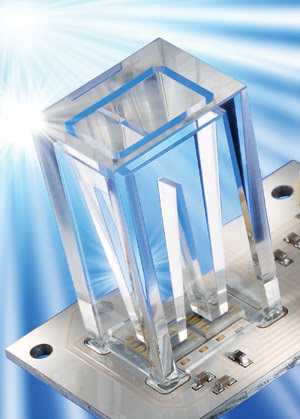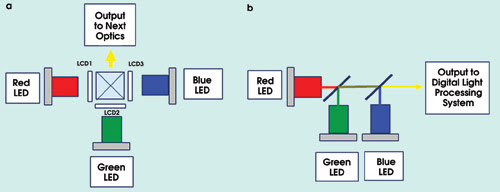As televisions go digital, the discharge lamp gives way to new LED designs.
Francis Nguyen and Dr. Nicole Breidenassel, Osram Opto Semiconductors Inc.
Television in the US is going digital as of Feb. 17, 2009, when, under a Federal Communications Commission (FCC) mandate, the analog television broadcast will end. The FCC has further mandated that, beginning July 1, 2007, all televisions sold in the US must have a built-in digital tuner. Manufacturers are looking at new designs and technologies for digital televisions, trying to find the highest resolution for the popular large-screen sizes at the lowest cost.
The benefits of digital television are many. It provides a clearer and more brilliant picture with higher resolution. High-definition television (HDTV), with a resolution of up to 1920 × 1080 pixels, provides almost twice the resolution of the old analog standard of 525 lines. Its aspect ratio (width divided by height of the screen) is 16:9, compared with the analog standard of 4:3. This higher resolution means that the lines on the screen are not discernible, as they are on an analog TV.
In addition, HDTV provides five channels of surround-sound capability, which, combined with the larger screen sizes resulting from higher resolution, enables a near-cinematic experience in home theaters. Interactive programming also is possible, such as viewer-selectable camera angles.
Today the consumer can choose from a number of flat screen technologies, including plasma, LCD and microdisplay rear-projection TV. All three technologies have their merits. Rear projection offers the lowest cost and highest resolution for screen sizes greater than 42 in. The higher resolution means that the individual pixels are not visible on the large-screen TVs.
The three key technologies driving rear-projection TVs are digital light processing, liquid crystal on silicon and LCD. All share a common light source from a discharge arc lamp. The lamp has two problems, however; it can take up to five minutes to warm up to full brightness, and it has a limited lifetime of 5000 to 6000 hours.
LEDs are an attractive alternative because they offer moderate thermal management with lifetimes in the range of 20,000 to 50,000 hours, so that customers don’t have to change an expensive lamp. All three LED light-source colors also can be driven independently, eliminating the color wheel in systems based on digital light processing and improving system reliability and cost. LED-based systems also provide more saturated colors, and screen brightness can be controlled by pulse-width modulation — the standard method used for brightness control by varying the lengths of current pulses to drive the LED.
To address the limitations of current light sources, a combination of a highly efficient LED die, innovative packaging and suitable primary optics is needed. A light source of this nature enables manufacturers to produce large-screen rear-projection TV with outstanding features such as instant on-off, no moving parts and pictures with saturated colors and high contrast.
In addition, LED technology has spawned the next generation of large, high-current, thin-film chips, with high efficiency and outstanding luminance. Innovative chips such as these pure surface emitters produce much higher luminance when used without reflectors than do conventional volume emitters.
Package design
In projection applications, package design is essential to bring as much light as possible onto the relatively small imager. Designers must consider not only the absolute brightness of the source, but also the law of etendue, which specifies the geometric capability of an optical system to transmit light throughput. The LED light source must emit light from a small area into a narrow solid angle (Figure 1).

Figure 1. This rear-projection TV module is an example of a new design using an insulated metal substrate. The electrostatic discharge protection diodes, a negative temperature coefficient sensor and a connector are preassembled on the substrate. Etendue-preserving primary optics direct the light from LEDs intoa small solid angle.
Designers also must achieve low thermal resistance for the mounting to keep the LEDs cool. The light output and the lifetime of an LED decrease very quickly with high operating chip temperatures. This problem can be alleviated by the choice of the component materials and by using a suitable design to provide effective heat dissipation and cooling.
The LED module also must be designed in such a way as to enable precise mounting of the primary optics, obviating the need for tedious manual alignment.
Optics, performance and cost
In a rear-projection TV LED module, light is collected and directed by etendue-preserving primary optics. Precise and well-defined chip placement and optics mounting result in correct alignment, which maximizes the light throughput.
The optics also must be designed so that the output angle matches the size of the imager, whether digital light processing, liquid crystal on silicon or LCD, to maximize light throughput.
Typically, three LED modules are needed: red, green and blue. The combination of highly efficient LED chips, efficient thermal management and suitable primary optics can produce more than 250 screen lumens, comparable to a 100-W discharge lamp (Figure 2).

Figure 2. Rear-projection TV manufacturers have a choice of a new light source. These examples of light engines show an LED and an LCD used in the design (a) and an LED and a digital light processor (b).
With proper thermal management and driving currents, lifetimes of four to five times that of a discharge lamp can be achieved with an LED light source. The higher initial cost of the LED system is quickly offset by not having to replace the discharge lamp every 5000 hours.
New LED designs
It is generally accepted that LED-based luminance on a rear-projection TV screen is strongly dependent on the chosen imager technology, the efficiency of the overall optical system, the gain factor of the screen, the screen size, the brightness target and the thermal management. LED sources available today provide 250 lm on-screen, resulting in a luminance of around 400 nits on a 56-in. screen.
LEDs for rear-projection TV applications are not only an alternative to traditional lamps, but also a reality, engineered with an intricate combination of efficient die, innovative packaging and suitable primary optics.
Meet the authors
Francis Nguyen is senior product manager for intelligent display and LED products at Osram Opto Semiconductors Inc. in San Jose, Calif.; e-mail: [email protected].
Nicole Breidenassel is senior applications engineer with Osram Opto Semiconductors in Bayern, Germany; e-mail: [email protected].